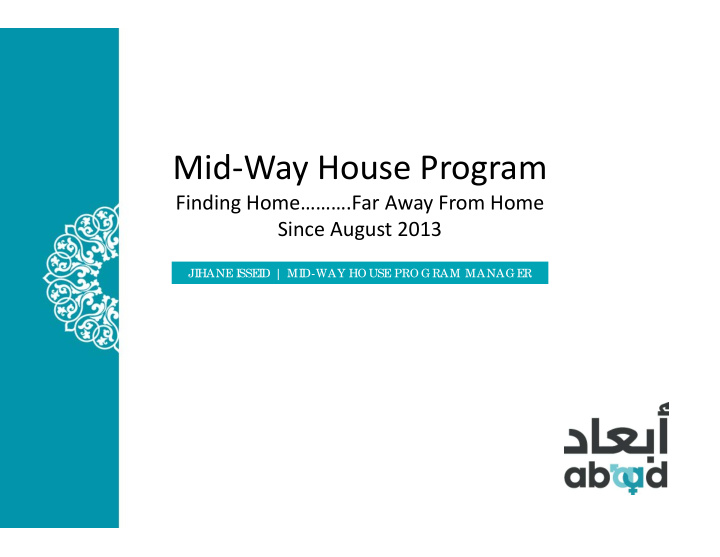



Mid ‐ Way House Program Finding Home……….Far Away From Home Since August 2013 JI HANE I SSEI D | MI D-WAY HO USE PRO G RAM MANAG ER
What is it about? The Mid ‐ way Transition House (Al Dar) is a free, safe, supportive temporary house for women & girls at risk or survivors of Gender ‐ Based Violence (GBV).
How can the Dar break the cycle of violence? The services offered by Al Dar create an Empowering Environment that provides women with an opportunity to grow, mature, and escape abusive situations. Al Dar contributes to building community awareness and strengthening local communities to better respond to GBV.
What Types of services we offer? • Immediate basic Assistance • Listening and crisis counseling services • Psycho ‐ social support and mental health services • Health & medical health services • Legal support • Education & Children Care Program • Referrals for provision of complementary welfare social services • Community capacity development and education
Who can benefit from the services of the MWH • Female adult of any age. • Girl adolescent child (12 ‐ 18) survivor or at immediate risk of GBV following a coordination with UPEL . • Girl child (0 ‐ 12) if accompanied with her mother or with a protective female family member following a coordination with UPEL . • Boy child (0 ‐ 8) can be accepted with his mother or a protective female family member following a coordination with UPEL .
Guiding Principles of the Mid ‐ Way House • Ensure the safety of the survivor and her family at all times. • Respect the confidentiality of the survivors and their family at all times. • Al ‐ Dar guarantees the anonymity of women and girls. • Respect the wishes, choices, rights and dignity of the survivor. • No violence of any kind is permitted. Al Dar ensures inclusive provision of services with no exclusion of any beneficiary on the grounds of nationality, race, class, sexuality, disability etc. • Best interest of the child .
MWH Organogram GBV ‐ CM, MHPSS ABAAD Legal DIRECTOR Technical Advisors MWH PROGRAM MANAGER PSYCHOTHERAPIST Driver MWH DIRECTOR Night Care Child PSS GBV ‐ CW PSS ‐ SW Attendants Educator
Referral & Admissions Procedure Admission Admission upon having approval of the GBV advisor Basic information should be shared with the committee: Profile, type of GBV, referral agency, eligibility to access the MWH Service Screening GBV Advisor GBV – CW ABAAD Call First entry point Center Any service provider (incl. LNGOs), INGOs’, Referring Governmental entities Self Referral agency/ (ISF,UPEL, MoSA)/ UN beneficiary agencies, etc.
MWH Strategy Of Intervention The structure of the MWH strategy aims at organizing the different roles and their intersections within the system to reach the common overall objective of the program while respecting the survivor centered approach. This structure will also facilitate and define: the steps of intervention to be followed after each admission and the planning of activities the specific objectives of intervention at each step based on the international guidelines for GBV CM and MHPSS The M&E procedures to follow throughout the support process presented to each beneficiary. Survivor ‐ centered approach is when the survivor of violence is empowered by prioritizing their needs, wishes and rights and ensuring their access to appropriate and good quality services (Ward, 2010; adapted from UNICEF, 2010.)
MWH Strategy Of Intervention • The overall objective of the intervention should be to address the physical, safety, psychosocial and legal needs of the GBV survivor and of their families while: 1 ‐ Respecting their wishes and priorities 2 ‐ Reinforcing their self ‐ help mechanisms 3 ‐ Facilitating their social reintegration
MWH Strategy Of Intervention
MWH Strategy Steps Of Intervention Step 5: Closure SSW -
MWH Step of Intervention & M&E Tools
Que stions?
HANK YOU! NAME T
Recommend
More recommend